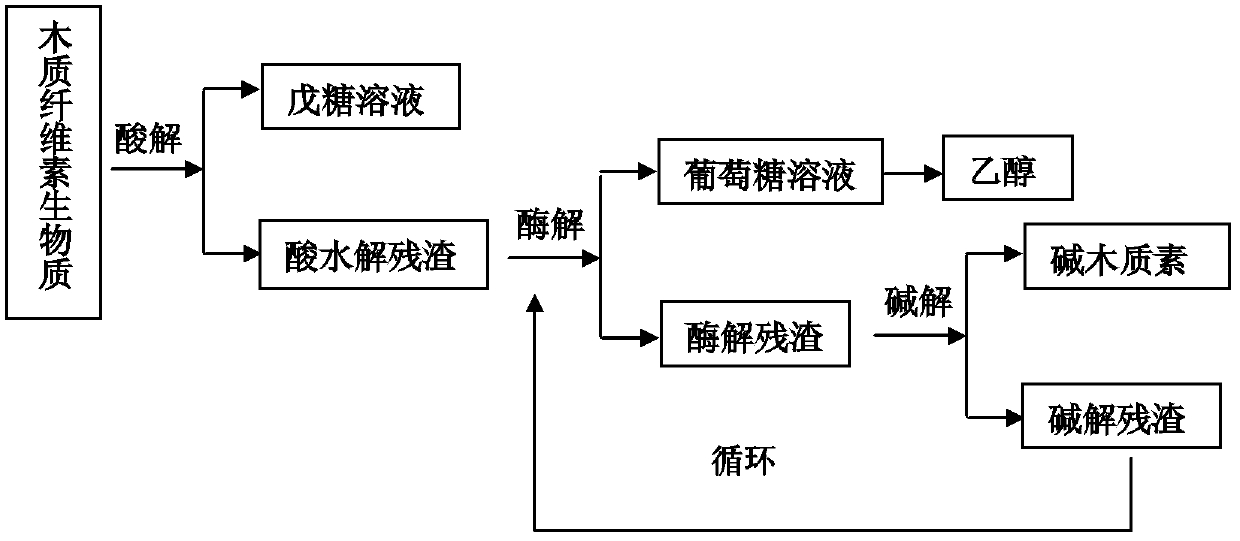Method for comprehensively utilizing lignocellulose biomass
A lignocellulose and biomass technology, applied in the field of comprehensive utilization of cellulose, hemicellulose and lignin in lignocellulosic biomass, can solve the problems of low enzymatic conversion rate of cellulose and low utilization rate of lignin, etc. To achieve the effect of improving the extraction rate, simplifying the production process and reducing pollution
- Summary
- Abstract
- Description
- Claims
- Application Information
AI Technical Summary
Problems solved by technology
Method used
Image
Examples
Embodiment 1
[0050] (1) acid hydrolysis
[0051] 10.6kg corn cobs (mass composition: moisture 6.12%, cellulose 35.19%, hemicellulose 32.1%, lignin 23.7%, other 2.95%, the same below) are broken, washed with water to remove dust, and then processed with 80kg phosphoric acid solution Hydrolysis, the mass concentration of phosphoric acid solution is 10%, the temperature of acid hydrolysis is 120 ℃, the time is 1 hour, the acid hydrolysis residue and pentose sugar solution obtained after hydrolysis are separated, wash the acid hydrolysis residue with 10kg water, cleaning solution Merge with described pentose solution, finally obtain 19.64kg acid hydrolysis residue (moisture content is about 65%, the absolute dry content of hemicellulose is 15.87%, the absolute dry content of lignin is 31.75%, the absolute dry content of cellulose 47.81%) and 80.34kg pentose solution, the concentration of pentose solution is 2.89%, and the extraction rate of hemicellulose is 68%.
[0052] The calculation formu...
Embodiment 2
[0067] (1) acid hydrolysis
[0068] Break 10.6kg of corncobs, wash with water to remove dust, and then hydrolyze with 80kg of phosphoric acid solution, the mass concentration of phosphoric acid solution is 20%, the temperature of acid hydrolysis is 100°C, and the time is 0.5 hours. After the hydrolysis is completed, the separated acid hydrolysis Residue and pentose solution, clean described acid hydrolysis residue with 10kg water, and cleaning solution merges with described pentose solution, finally obtains 19.35kg acid hydrolysis residue (moisture content is about 65%, and the dry content of hemicellulose is 15.10 %, the dry content of lignin is 31.79%, the dry content of cellulose is 48.47%) and 80.63kg pentose solution, the concentration of pentose solution is 2.96%, and the extraction rate of hemicellulose is 70%.
[0069] (2) Enzymatic hydrolysis of cellulose
[0070] Take all the acid hydrolysis residue obtained in step (1) as the cellulose substrate, and carry out cell...
Embodiment 3
[0078] (1) acid hydrolysis
[0079] Break 10.6kg of corn cobs, wash with water to remove dust, and then hydrolyze with 80kg of phosphoric acid solution, the mass concentration of phosphoric acid solution is 5%, the temperature of acid hydrolysis is 150°C, and the time is 1 hour. After the hydrolysis is completed, the separated acid hydrolysis Residue and pentose solution, wash described acid hydrolysis residue with 10kg water, and cleaning liquid merges with described pentose solution, finally obtain 20.02kg acid hydrolysis residue (water content is about 65%, and the dry content of hemicellulose is 16.05% %, the dry content of lignin is 31.5%, the dry content of cellulose is 47.97%) and 79.96kg pentose solution, the concentration of pentose solution is 2.86%, and the extraction rate of hemicellulose is 67%.
[0080] (2) Enzymatic hydrolysis of cellulose
[0081] Take the acid hydrolysis residue described in step (1) as the cellulose substrate, and carry out cellulose enzymol...
PUM
 Login to View More
Login to View More Abstract
Description
Claims
Application Information
 Login to View More
Login to View More - R&D Engineer
- R&D Manager
- IP Professional
- Industry Leading Data Capabilities
- Powerful AI technology
- Patent DNA Extraction
Browse by: Latest US Patents, China's latest patents, Technical Efficacy Thesaurus, Application Domain, Technology Topic, Popular Technical Reports.
© 2024 PatSnap. All rights reserved.Legal|Privacy policy|Modern Slavery Act Transparency Statement|Sitemap|About US| Contact US: help@patsnap.com








